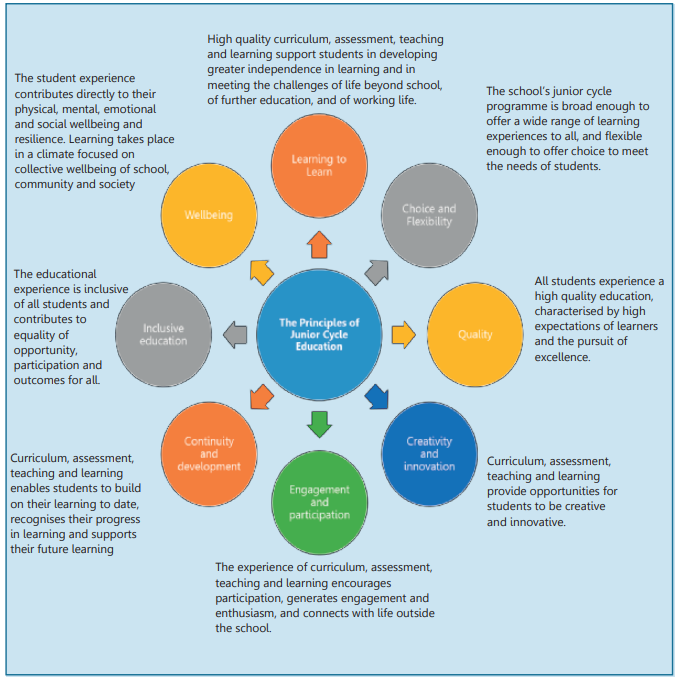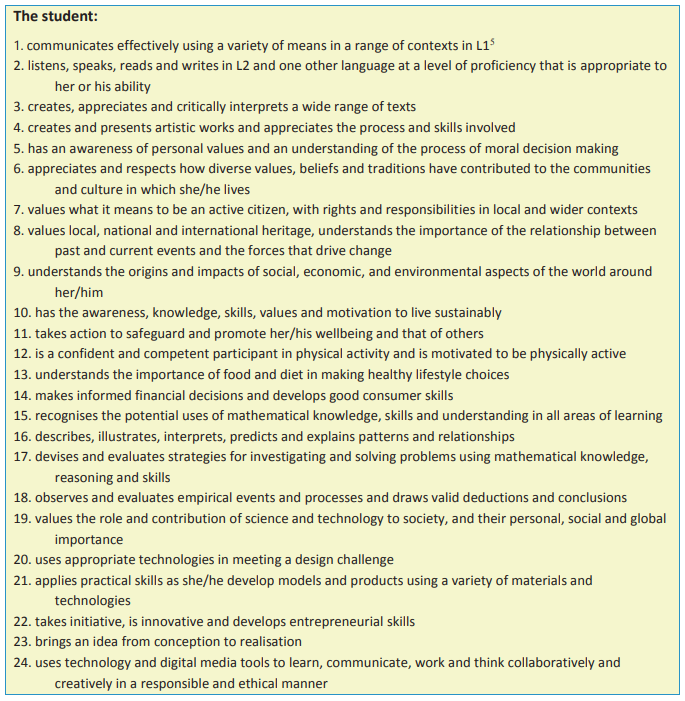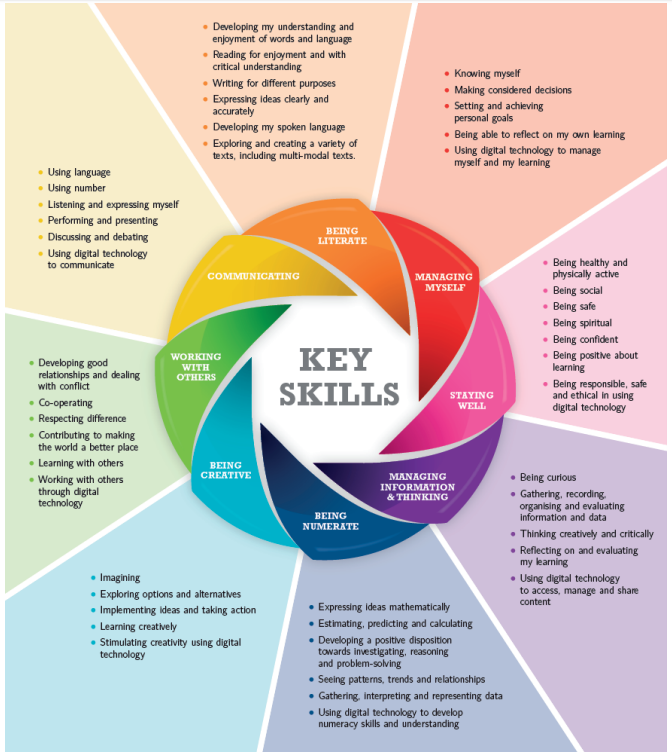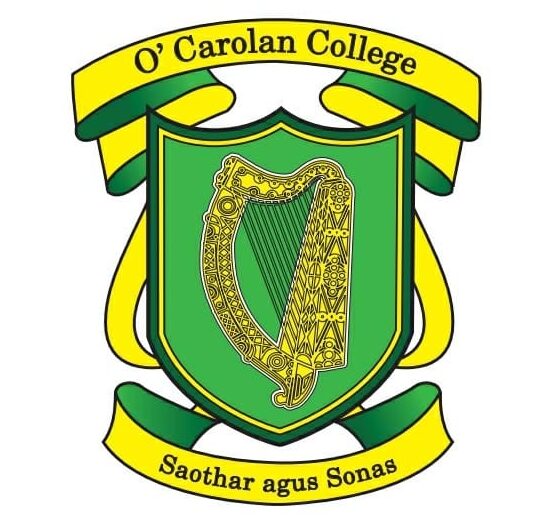Guide to Junior Cycle
Beginning on a phased basis from September 2014, the new Junior Cycle will feature revised subjects and short courses, a focus on literacy, numeracy and key skills, and new approaches of assessment and reporting. Schools will have more freedom to design Junior Cycle programmes that meet the learning needs of all students. For students, the new Junior Cycle will mean that the curriculum available in their schools will be a mix of subjects and short courses as well as other learning experiences.
This information can be found in PDF form, published in leaflets from the Junior Cycle for Teachers (JCT) team.
This article is broken into the following sections, to help outline the structure of the new Junior Cycle.
Key principles of Junior Cycle.
Statements of learning for Junior Cycle.
The key skills of Junior Cycle.
The use of specifications in Junior Cycle.
Assessment in Junior Cycle.
Most of the information in this article has been adopted from the Framework for Junior Cycle, 2015.
The Principles of Junior Cycle

Statements of Learning in Junior Cycle
Classroom practise is now informed by an over-arching set of 24 statements of learning, which the students engage with over the course of their Junior Cycle experience. The 24 statements, which are underpinned by the eight principles, are central to planning for, the students’ experience of, and the evaluation of the school’s junior cycle programme. Schools will ensure that all statements of learning and the eight key skills feature in the programmes offered to their junior cycle students. Each individual subject is provided with a set of learning outcomes, set out in individual subject specifications.
The statements of learning are presented in the following table.

The Key Skills of Junior Cycle
There are eight key skills required for successful learning by students across the curriculum and for learning beyond school. Through experiencing student-centered learning focused on the 8 under pinning principles, and 24 statements of learning, the students will engage the key skills of Junior Cycle. The key skills are as follows: being literate, managing myself, staying well, managing information and thinking, being numerate, being creative, working with others and communicating.
The individual skills are explained in depth in the following diagram.
Throughout the Junior Cycle, students will acquire and enhance their proficiency in these eight key skills. These will be brought to life through the learning experiences encountered by students and will be evident in the assessment approaches used in the classroom and in examinations. These skills are key to learning in every area of junior cycle and beyond. They are closely linked to the skills required at senior cycle and those already developed for early childhood and primary education.
The key skills are embedded in the learning outcomes of every junior cycle subject, found in the subject specifications. Thus, teachers will have a clear understanding of how they fit into a subject or priority learning unit and how to build the skills into class planning.

The Use of Specifications in Junior Cycle
The previous Junior Cycle course followed subject syllabi (singular – syllabus). These were documents which provided a list of specific in-depth learning objectives, specifically indicating what teaching and learning was to occur in the classroom.
The new Junior Cycle specifications have replaced the use to syllabi. A specification is a document which provides learning outcomes, instead of objectives. The learning outcomes are statements in curriculum specifications to describe the knowledge, understanding, skills and values students should be able to demonstrate after a period of learning. They indicate what the end product of the teaching and learning should be, but do not indicate how the students and teachers cooperate to arrive at the learning outcome. This allows for flexibility in the teaching and learning that occurs and allows for teachers to design specific lessons to achieve a learning outcome, or set of outcomes, in a manner most appropriate for the group of students in a classroom.
In order to do this, teachers are required to interpret the specification in light of the learning outcomes and determine what content is appropriate to cover to achieve these goals.
Assessment in Junior Cycle
Before the end of the first term following the completion of the Junior Cycle, each student will receive a composite Junior Cycle Profile of Achievement (JCPA). This will document the full range of the student’s learning achievements. They will include evidence of student’s achievement gathered over their 3 year cycle in the area of national examination results, classroom based assessments (CBA’s) and other areas of learning (OAL). This section will look closer at these three elements.
National Examination Results
During year 3 of Junior Cycle, the students undertake two national assessments, the state examinations in June and the assessment task (AT).
The state examinations are drafted by the state examinations commission (SEC). Student performance on these examinations contributes 90% of their national examination results. These exams are drafted to indicate the student progress in achieving the learning outcomes listed in the specification. As there is not always specific content required to be covered in some of the new Junior Cycle specifications, these exams are not designed to be answered by just memory – recall. Instead, they should demonstrate what the students can do with their knowledge and understanding of a subject. Students can sit either a higher level and ordinary level examination for English, Irish and Mathematics only. All other subjects are completed at a common level for all students.
Student performance on the assessment task contributes 10% of their national examination results. The assessment task may require students to demonstrate an understanding of the knowledge and skills developed during their second classroom-based assessment. It facilitates the student in highlighting key learning points gained as the student undertook the classroom-based assessment in question. It also gives the students the opportunity to reflect and consider how they implemented the key skills in their completion of the 2nd classroom-based assessment. In some subjects, the assessment task also provides an opportunity for students to refer to skills and competences that were developed and describe ways in which their learning might be applied to new situations. Assessment tasks are completed in class under the supervision of their teachers, and are sent to the state examinations commission for marking along with the script for that subject in the state-certified examination. All assessment tasks are undertaken at common level for all students, in all subjects.
Classroom-Based Assessments
Assessing skills can be a challenging to do in a written examination. The new Junior Cycle introduced classroom-based assessments, that are separate from the national assessments, as a more viable manner in accurately assessing the development of students’ skills, in the different subjects. Each of the full course subjects have 2 classroom-based assessments. The first of these is completed in 2nd year, while the second is completed in 3rd year.
A particular purpose of the classroom-based assessments is to facilitate developmental feedback to students during their engagement with the assessment task and at the end of the process. The tasks involved in the classroom-based assessments are specified by the NCCA, in consultation with the SEC on an annual basis. Features of quality are used as a benchmark for assessment, which have been drafted at national level. This allows the teachers and students to develop their own tasks for their classroom-based assessments, as long as they appropriately demonstrate the key skills listed in the features of quality. Classroom-based assessments are all set at a common level, regardless of subject.
Other Areas of Learning
This section provides an opportunity for schools to report on student achievement in other areas of learning including short courses that may have been included in the school’s junior cycle programme. It may also report on other learning experiences and events that the student has participated in. Schools may also wish to include broader aspects of reporting in this section, or areas such as attendance, personal and social development and learning dispositions.
The Junior Cycle Profile of Achievement (JCPA) gathers evidence from these three domains of students learning and experiences onto one document. It allows for a more comprehensive set of results that indicates how students engaged in the learning process of the Junior Cycle programme, and indicates their progress at the end of the programme.
